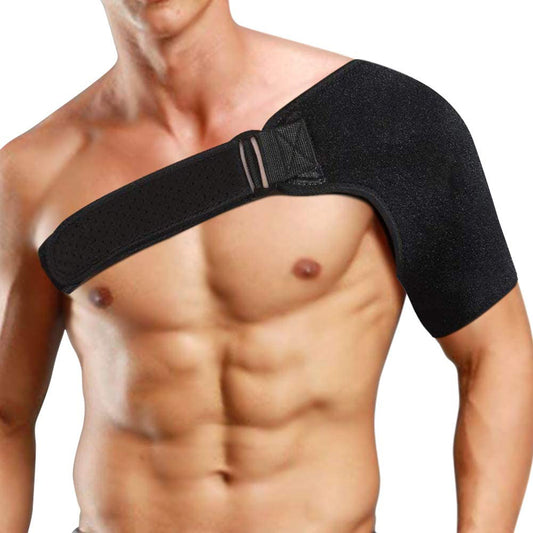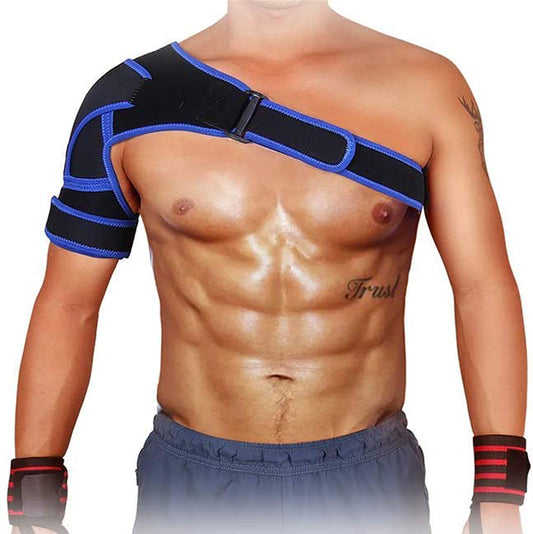-
Shoulder Brace for Men and Women for Torn Rotator Cuff Support,Tendonitis, Dislocation, Bursitis, Neoprene Shoulder Compression Sleeve Wrap
Regular price $16.99 USDRegular price$25.99 USDSale price $16.99 USDSale -
Tourmaline Warm Brace Self Heating Massage Belt for Neck Shoulder Support Brace
Regular price $21.99 USDRegular price$21.99 USDSale price $21.99 USD -
Compression Shoulder Support Brace, Adjustable Neoprene Upper Arm and Shoulder Wrap Pain Relief for Rotator Cuff Shoulder Tear Injury AC Joint Dislocation Prevention and Recovery
Regular price $26.99 USDRegular price$39.00 USDSale price $26.99 USDSale -
Shoulder Brace Adjustable Rotator Cuff Support for Men or Women Breathable Neoprene Compression Sleeve Wrap Left or Right Shoulder Medium
Regular price $36.99 USDRegular price$36.99 USDSale price $36.99 USD -
Compression Recovery Shoulder Brace - Adjustable Fit Sleeve Wrap Men Women. Relief for Shoulder Injuries, Tendonitis
Regular price $26.99 USDRegular price$39.00 USDSale price $26.99 USDSale -
Shoulder Support Brace for Men and Women Athletic | Orthopedic Care Shoulder Brace for Torn Rotator Cuff
Regular price $26.99 USDRegular price$39.00 USDSale price $26.99 USDSale
Collection: Essential Shoulder Braces: Support and Relief for Injury and Recovery
Essential Shoulder Braces: Support and Relief for Injury and Recovery
Shoulder injuries can impede both daily routines and athletic endeavors. Compression Recovery Shoulder Brace - Adjustable Fit Sleeve wraps are designed to provide pain relief and expedite the recovery process for shoulder injuries and tendonitis. Explore the myriad benefits of supportive shoulder gear.
Who Needs Shoulder Braces?
Our ZSZBACE brand shoulder braces are suitable for:
- Athletes and active individuals: Those involved in sports or exercise who are prone to shoulder strains or require prevention methods for recurrent injuries.
- Individuals with shoulder injuries: Whether you're recovering from a rotator cuff tear, shoulder dislocation, or another injury, a brace provides critical support.
- Older adults: People experiencing limited mobility due to conditions such as osteoarthritis can benefit from additional joint support.
- People with tendonitis or shoulder impingement: Conditions like these require compression and stabilization to aid recovery.
Why You Need a Shoulder Brace
A shoulder brace offers several benefits crucial for both injury recovery and prevention:
- Support and Immobilization: By limiting movement, a brace can prevent further injury and allow healing.
- Pain Relief: The compression offered by the brace can reduce swelling and discomfort.
- Enhanced Posture: Regular use aligns shoulders, potentially reducing pain related to poor posture.
For those experiencing shoulder pain or recovering from injuries, shoulder braces, such as the Compression Shoulder Support Brace, provide adjustable support and relief.
How to Determine if You Need a Shoulder Brace
Diagnosing shoulder issues often involves paying attention to the symptoms:
- Persistent Pain: Continuous discomfort or pain during motion signals an underlying issue.
- Limited Range of Motion: Difficulty in lifting or rotating your arm may suggest the need for supportive gear.
- Swelling or Tenderness: Visible or palpable signs around the shoulder area.
Advice for Use: It is crucial to consult with a healthcare professional for an accurate diagnosis and recommendation before using a shoulder brace.
Characteristics of Our Shoulder Braces
Our shoulder braces are crafted with the following features:
- Adjustable Fit: Ensures tailored support, accommodating various sizes for both men and women.
- Breathable Neoprene Material: Provides comfort, maintaining warmth while allowing ventilation.
- Universal Design: Fits the left or right shoulder, useful for any orientation.
Explore our Shoulder Brace Adjustable Rotator Cuff Support for a versatile, breathable option that aids in rotator cuff and shoulder stability.
Common Questions About Using Shoulder Braces
Q: Can I wear the brace while sleeping?
A: Yes, our shoulder braces are designed to be comfortable for extended wear, including overnight.
Q: How long should I wear the brace each day?
A: This varies by individual and condition; consult with a healthcare provider. Generally, wearing it during times of activity provides significant benefits.
Q: Will it restrict my movement too much?
A: While the brace limits excessive motion to prevent further injury, it maintains a degree of flexibility for necessary movements.
Suitable Symptoms for Shoulder Braces
Condition-specific applications include:
- Rotator Cuff Injuries: Enhances rehabilitation by stabilizing shoulder mechanics.
- Tendonitis: Alleviates pressure and aids the natural healing process.
- AC Joint Dislocation: Promotes stabilization and healing after sprains.
Visit our website to learn more about the benefits and usage of our range of shoulder braces and to find the best option for you.
Why Choose ZSZBACE Shoulder Braces?
With years of expertise in manufacturing shoulder support products, ZSZBACE delivers top-notch materials, professional service, and reliable after-sales support. Trust us to provide robust solutions for your shoulder injury and recovery needs.
Your path to recovery is just a compression recovery shoulder brace away. Choose our products to ensure optimal support and a speedy recovery.






